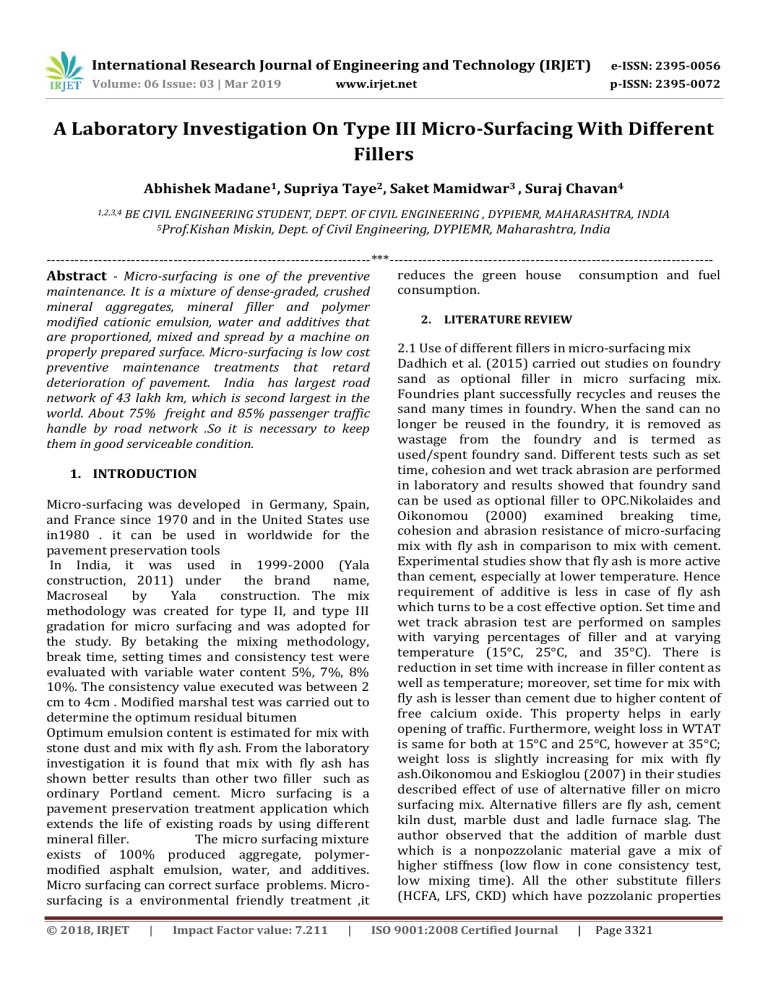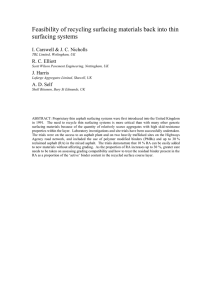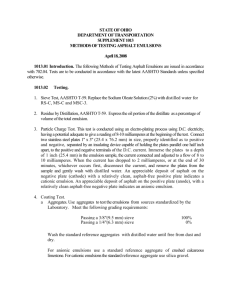IRJET-A Laboratory Investigation on Type III Micro-Surfacing with different Fillers
advertisement

International Research Journal of Engineering and Technology (IRJET) e-ISSN: 2395-0056 Volume: 06 Issue: 03 | Mar 2019 p-ISSN: 2395-0072 www.irjet.net A Laboratory Investigation On Type III Micro-Surfacing With Different Fillers Abhishek Madane1, Supriya Taye2, Saket Mamidwar3 , Suraj Chavan4 1,2,3,4 BE CIVIL ENGINEERING STUDENT, DEPT. OF CIVIL ENGINEERING , DYPIEMR, MAHARASHTRA, INDIA 5Prof.Kishan Miskin, Dept. of Civil Engineering, DYPIEMR, Maharashtra, India ---------------------------------------------------------------------***--------------------------------------------------------------------reduces the green house consumption and fuel Abstract - Micro-surfacing is one of the preventive consumption. maintenance. It is a mixture of dense-graded, crushed mineral aggregates, mineral filler and polymer 2. LITERATURE REVIEW modified cationic emulsion, water and additives that are proportioned, mixed and spread by a machine on 2.1 Use of different fillers in micro-surfacing mix properly prepared surface. Micro-surfacing is low cost Dadhich et al. (2015) carried out studies on foundry preventive maintenance treatments that retard sand as optional filler in micro surfacing mix. deterioration of pavement. India has largest road Foundries plant successfully recycles and reuses the network of 43 lakh km, which is second largest in the sand many times in foundry. When the sand can no world. About 75% freight and 85% passenger traffic longer be reused in the foundry, it is removed as handle by road network .So it is necessary to keep wastage from the foundry and is termed as them in good serviceable condition. used/spent foundry sand. Different tests such as set time, cohesion and wet track abrasion are performed 1. INTRODUCTION in laboratory and results showed that foundry sand can be used as optional filler to OPC.Nikolaides and Micro-surfacing was developed in Germany, Spain, Oikonomou (2000) examined breaking time, and France since 1970 and in the United States use cohesion and abrasion resistance of micro-surfacing in1980 . it can be used in worldwide for the mix with fly ash in comparison to mix with cement. pavement preservation tools Experimental studies show that fly ash is more active In India, it was used in 1999-2000 (Yala than cement, especially at lower temperature. Hence construction, 2011) under the brand name, requirement of additive is less in case of fly ash Macroseal by Yala construction. The mix which turns to be a cost effective option. Set time and methodology was created for type II, and type III wet track abrasion test are performed on samples gradation for micro surfacing and was adopted for with varying percentages of filler and at varying the study. By betaking the mixing methodology, temperature (15°C, 25°C, and 35°C). There is break time, setting times and consistency test were reduction in set time with increase in filler content as evaluated with variable water content 5%, 7%, 8% well as temperature; moreover, set time for mix with 10%. The consistency value executed was between 2 fly ash is lesser than cement due to higher content of cm to 4cm . Modified marshal test was carried out to free calcium oxide. This property helps in early determine the optimum residual bitumen opening of traffic. Furthermore, weight loss in WTAT Optimum emulsion content is estimated for mix with is same for both at 15°C and 25°C, however at 35°C; stone dust and mix with fly ash. From the laboratory weight loss is slightly increasing for mix with fly investigation it is found that mix with fly ash has ash.Oikonomou and Eskioglou (2007) in their studies shown better results than other two filler such as described effect of use of alternative filler on micro ordinary Portland cement. Micro surfacing is a surfacing mix. Alternative fillers are fly ash, cement pavement preservation treatment application which kiln dust, marble dust and ladle furnace slag. The extends the life of existing roads by using different author observed that the addition of marble dust mineral filler. The micro surfacing mixture which is a nonpozzolanic material gave a mix of exists of 100% produced aggregate, polymerhigher stiffness (low flow in cone consistency test, modified asphalt emulsion, water, and additives. low mixing time). All the other substitute fillers Micro surfacing can correct surface problems. Micro(HCFA, LFS, CKD) which have pozzolanic properties surfacing is a environmental friendly treatment ,it © 2018, IRJET | Impact Factor value: 7.211 | ISO 9001:2008 Certified Journal | Page 3321 International Research Journal of Engineering and Technology (IRJET) e-ISSN: 2395-0056 Volume: 06 Issue: 03 | Mar 2019 p-ISSN: 2395-0072 www.irjet.net especially in this low gradation (<200μm) showed more interesting results and in some cases (HCFA, LFS) better than OPC use (e.g. in cohesion test and WTAT for longer time testing).Gujar (2013) suggested use of rice husk ash as substitute for cement in micro-surfacing. Rice milling produces byproduct known as husk. During milling, 25% of weight is converted into ash during firing process which is known as rice husk ash. Tests performed on mix are mix time, consistency, cohesion, wet track abrasion test and wet stripping test. From experiments, it is found that mixing time for mix with rice husk ash is greater than mix with cement hence it can be used in the regions having low temperature. Mix failed in wet track abrasion test hence it can’t be used for high traffic volume roads. Low specific gravity is also one of the reasons. Use of rice husk ash makes the mix cost effective but it does not improve quality of micro surfacing. Rice husk ash with cement can be used to improve preventive maintenance. Gujar et al. (2012) described the use of fly ash as mineral filler in micro surfacing mix. Conventional filler, cement is replaced by fly ash. In this experimental investigation breaking time of the emulsion, the cohesion and the abrasion resistance of micro surfacing material with fly ash is examined. Author performed cohesion and wet track abrasion test. Results for fly ash are almost equal to cement, even better than cement. Hence cement can be replaced fly ash which reduces pollution caused by dumping of fly ash as well as cost of production. 2.2 Effect of material characteristics on microsurfacing mix Lonbar and Nasrazadani (2015) established relationship between aggregate and binder to rut resistance of the pavement. Two aggregate sources and binders are taken to examine properties of mix and their performance. Wheel tracking test is performed to check the performance. Aggregate gradation for both aggregate kept same. By experiments it is concluded that river aggregate are more resistant to rutting than mountain aggregate. Rut depth for resin mix is much smaller than emulsion mix and also rut depth decreases with increase in resin. It is also seen that there is increase in rut depth with increase in emulsion content. Rate of rut growth after 500 cycles is increased with constant slope which indicates that rut depth is growing after some initial compression which means that primary compaction can be suitable for microsurfacing layer. Jae Kyu Lim et al. (2014) described © 2018, IRJET | Impact Factor value: 7.211 | effect of water and emulsion content on performance of micro surfacing mix. In their studies, type III gradation was considered with cement as filler. Tests performed are cohesion and wet track abrasion test. During investigation it is found that abrasion rate is decreased with increase in water contents regardless different emulsion contents. Cohesion test shows increase in torque value with increase in emulsion content regardless different water contents. They observed that lesser water content needs more curing time to open traffic. 2.3 Case studies carried out in micro-surfacing Kumar and Ryntathiang (2012) described construction process of wearing course of pavement with micro-surfacing which reduces the both direct and indirect cost and experience of micro-surfacing at IIT Guwahati approaching road. Mixing procedure consists of adding crusher dust and cement in pre wet drum, dry mixing, addition of water, and emulsion followed by thorough mixing of all the contents. A rope having thickness greater than micro-surfacing thickness can be used to ensure uniform cover of micro-surfacing layer and road can be opened to traffic once surface is dry (about two or more hours). Micro surfacing mix was designed at the laboratory and laid on a 20 m test section to fill up the spalled concrete of a cast in situ concrete block pavement at approach of IITG campus. Type III gradation of aggregate was used in the mix. Initially all spalled edges were filled with micro-surfacing and a micro-surfacing layer of 15 mm was laid and roller compacted with few passes to smoothen the surface. After eight months, pavement was in good condition except minor reflection cracks. Micro-surfacing can be implemented for rural road maintenance.AppaRoa et al. (2013) made the comparison between hot mix and cold mix technology in terms of energy consumption green highway can be defined by five topics such as conservation and eco-system management, water shed driven strong water management, life cycle energy and emission reduction, recycles reuse and renewable, overall social benefits. Research studies showed that one ton of HMA produces about 5.25 kg of carbon which can stop by implementing the Micro surfacing. For the production of aggregate, GHG emission range is 2.5to10 kgCO2/t. For asphalt it is 221kg CO2/t. The study developed “eco-efficiency” indices for the five categories and found that micro-surfacing had a substantially lower environmental footprint than the other options. USA recycled 73 million metric ton of ISO 9001:2008 Certified Journal | Page 3322 International Research Journal of Engineering and Technology (IRJET) e-ISSN: 2395-0056 Volume: 06 Issue: 03 | Mar 2019 p-ISSN: 2395-0072 www.irjet.net asphalt pavement out of 91 million metric ton. Recycled material used in rehabilitation project, road widening project and construction of embankments and shoulders etc. 3. METHODOLOGY Material emulsified asphalt – asphalt is a naturally occurring product obtained from the distillation of crude petroleum product in a residue. Emulsion is mixture of asphalt ,water ,emulsifying agent emulsion used in micro surfacing such that it can produce resistance to traffic. Aggregate- - aggregate is important factor in micro surfacing. Aggregate should be properly graded. Following are gradation of aggregate Type I –It can observe moderate surface distress. Penetration of small crack depend on fineness of mixture.It can fill air void. Type II- it can fill air void and seal. Aggregate gradation observe serve surface distress and provide durable wearing coarse. Type III-aggregate gradation provide maximum skid resistance and improve wearing coarse. Mineral filler –the different type of mineral filler are used in micro surfacing. Such as stone dust , fiy ash , hydrated lime, lime stone etc. Additative- additative used in micro surfacing such as redicoteE-11, Redicote-500 etc which accelerate or retard the micro surfacing mix. Methodology- it is laboratory investigation so different tests are to be carried out Test on Aggregates a. Soundness test b. Los Angeles abrasion test c. Sand equivalent test Test on Emulsified Asphalt: a. Penetration test b. Softening point test c. Viscosity test d. Sieve test Test on Micro-surfacing Mix : a. Cone consistency test b. Wet track abrasion test c. Loaded wheel test The necessity of the above tests: I) TESTS ON AGGREGATE 1) Soundness test (ASTM C88) -:The soundness test is an empirical screening test that is intended to provide an indication of the aggregate durability due to weathering. This test is useful for evaluating new sources of aggregate for which no service records are available. © 2018, IRJET | Impact Factor value: 7.211 | 2) Sand equivalent test (ASTM D2419) -:The sand equivalent test is used to determine the relative proportions of plastic fines and dust in fine aggregates. 3) Los Angeles abrasion test (ASTM C131) -:This test is often used to obtain an indication of the desired toughness and abrasion characteristics. II) TESTS ON EMULSIFIED ASPHALT 1)Particle charge test (ASTM D7402-09) -:The particle charge test is carried out to identify the emulsion charge. It is performed by immersing a positive electrode (anode) and negative electrode (cathode) into a sample of emulsion and connecting electrode to a controlled directcurrent electric source. 2)Viscosity test (ASTM 2170) -:Viscosity is defined as a fluid’s resistance to flow. The Saybolt Furol viscosity test as described for asphalt cements is used for emulsified asphalt to measure and specify consistency properties. 3)Penetration test (IS 1203-1978) -:It is an empirical measure of consistency in which a container of residual asphalt cement is brought to test temperature of 25°C in a water bath. 4)Residue by evaporation test (ASTM D244) -:This test is designed to measure the percentage of asphalt cement in the emulsion by evaporating the water. The residue derived from this procedure usually yields lower penetration and lower ductility than that from distillation. III) TESTS ON MICRO-SURFACING MIX 1) Cone consistency test (ISSA TB 106) -:The cone test is used to determine the amount of water required to form a stable, workable mixture. This test uses the sand absorption cone of standard size described in ASTM C-128 and a base flow scale. 2) Wet track abrasion test (ISSA TB 100) -:This test method covers measurement of wearing qualities of slurry seal mixture systems under wet abrasive conditions. A slurry mix of fine graded aggregate, asphalt emulsion and water is prepared to a homogeneous flowing consistency. The mixture may contain Portland cement, hydrated lime and/or other additives. 3) Test method for measurement stability and resistance to compaction, vertical and lateral displacement of multilayered fine aggregate cold mixes (ISSA TB 147) :These methods cover three test procedures which measure the amount of compaction or displacement characteristics of multilayered, dense graded, fine aggregate cold mixes such as slurry seal or cold micro asphalt bituminous surfaces under simulated rolling traffic compaction by loaded wheel test. 4) Test method for measurement of excess asphalt in bituminous mixture by use of loaded wheel tester and sand adhesion (ISSA TB 109) -:The loaded wheel test is intended to compact fine aggregate bituminous mixtures such as slurry seal by means of a loaded rubber tired reciprocating wheel. The test may be used for design purpose to establish maximum limits of asphalt content ISO 9001:2008 Certified Journal | Page 3323 International Research Journal of Engineering and Technology (IRJET) e-ISSN: 2395-0056 Volume: 06 Issue: 03 | Mar 2019 p-ISSN: 2395-0072 www.irjet.net and enable the mix designer to avoid severe asphalt flushing under heavy traffic loads. 4. CONCLUSIONS 1) Micro surfacing is an effective surface treatment to prolong the life span of paved roads by preserving or improving the condition of paved roads. 2) Micro-surfacing used as a preventative treatment, corrective treatment, or holding strategy, micro surfacing lowers pavement life-cycle costs. 3) Micro surfacing can deliver excellent performance on wheel ruts, small surface cracks, and reintroduce skid resistance to pavement surfaces while lowering energy requirements and lowering greenhouse gas emissions REFERENCES 1.GautamDadhich, Dr. V.M.Patel, AbhijitsinhParmar, Dhaval M. Patel and BhupeshKatariya (2015).“Comparative Study on Use of Foundry Sand as Alternative Filler in Micro-surfacing Incorporating Type III Aggregate.” Indian Journal of Applied Science, Vol. 5(1), 81-83. 2.Nikolaides, A., and Oikonomou, N. (2000). “The Use Fly Ash as a Substitute of Cement in Micro-surfacing.” Waste Management, Series 1, 234-240. 3.Rajesh S. Gujar and Krupesh A. Chohan (2012).“Application of Fly Ash as Optional Filler in Micro-surfacing Mix.”International Journal of Civil, Structural, Environmental and Infrastructure Engineering Research and Development. Vol. 2(4), 17-22. 4.Jae-kyu-Lim, Boo-Il Kim, Jae-Cheong Hong, HyunJin Sin, Jae-Jun Lee and KangHwi Lee (2014). “Effect of Water and Emulsion Contents for Micro-surfacing Mix 5.Kumar.R., and Ryntathiang, T. L (2012). “IIT Guwahati: Department of Transportation Experience with Micro-surfacing.” International Journal of Computer Applications (IJCA), 4-8. 6.AppaRoa, G., Kumar, R., Amar, D., and Ryntathiang, T. (2013), “Green Road Approach for the Sustainable Development in India.” European Journal of Sustainable Development, Vol. 2(4), 165-176 © 2018, IRJET | Impact Factor value: 7.211 | ISO 9001:2008 Certified Journal | Page 3324


